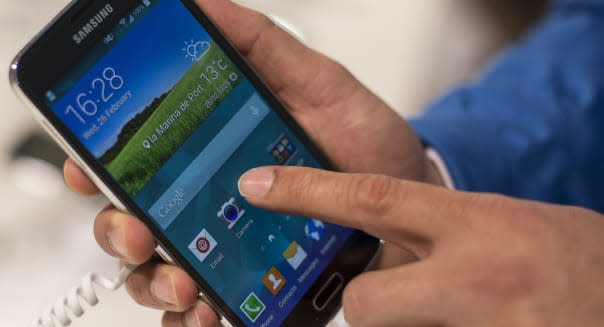Why Are Smartphones Supersizing? Look to Asia for an Answer

At this rate, we're all going to need bigger pockets soon.
Smartphones keep growing, in more ways than one. Big-screen phones accounted for more than one-third of global shipments in the first quarter of 2014, according to market researcher Canalys. Global shipments of phones with screens totaling 5 inches or more grew an astonishing 369 percent in the first quarter. Compare that to a mere 29 percent growth in shipments for the smartphone market. The trend reverses the norm for electronics -- the inexhaustible drive toward ever-smaller forms.
The "bigger and better" movement's beginnings can be traced back to Asia. Samsung (SSNLF) found that Asian consumers wanted more space to make it easier for them to write characters in their native languages on the touchscreen. Samsung has been doing brisk business selling phones with relatively wide screens. Its current flagship model, the Galaxy S5, comes in at 5.1 inches.
Samsung is currently the world's top vendor, holding an estimated 31 percent of the market as of the end of the first quarter. That's nearly double the share of No. 2 Apple (AAPL).
The Market Goes Where the Leader Takes It
Apple's current 5 series of phones spans 4 inches in diagonal length, half an inch wider than that of the preceding 4 series. The famously secretive company isn't spilling the beans about its upcoming set of phones, but media reports have it that one model will boast a 4.7-inch screen, and another will span 5.5 inches.
Even Nokia (NOK), which years ago ruled the market by selling pre-smartphone basic models with tiny displays, has gone big lately. Screens in its Lumia line range from 4.5 to 6 inches.
For its first foray into smartphones, Amazon.com (AMZN) will have a 4.7-inch screen for the Fire Phone.
In Western markets, there's little or no need to trace intricate linguistic characters on a screen. Rather, what's driving the increase in size is technology and consumer demand.
One of the key reasons consumers buy a smartphone is to have robust multimedia capability at their fingertips. "Angry Birds," "Game of Thrones" and pictures of baby are more engaging for many users if they can be enjoyed on a larger display.
Tablet Trauma Ahead?
The bulking up of smartphone displays imperils tablets. Why own two devices when you can spring for a product that has the critical features of both -- a nice wide screen and a means to call people?
%VIRTUAL-article-sponsoredlinks%This has led influential market researcher IDC to shave its forecast for global sales of tablets and two-in-one (laptop PC/tablet) devices. The company now believes that 245 million units of such goods will be sold, down from the previous projection of nearly 261 million.
That decline is discouraging for Apple, which in its most recent quarter drew nearly 25 percent of its total product unit sales from the iPad line of tablets.
It's also an uncomfortable trend for other energetic tablet producers that have devoted plenty of resources to improving their offerings. Microsoft (MSFT) just introduced its Surface 3, while Amazon's top-of-the-line Fire HDX was unveiled less than a year ago to much fanfare.
Big Is Bountiful
Since every significant player on the market is jumping on the bandwagon, the big-phone trend is almost certainly here to stay. It says something that Apple is now diving headfirst into it, as former CEO Steve Jobs refused to go above a 3.5-inch screen during his tenure.
So, no matter your preferences, it looks like your smartphone is going to bulk up in the near future. Hopefully, you've got big enough hands to use it smoothly and a large enough place to store it when you're not watching movies, placing calls or recording videos with it.
Motley Fool contributor Eric Volkman has no position in any stocks mentioned. The Motley Fool recommends Amazon.com and Apple, and it owns shares of Amazon.com, Apple and Microsoft.

